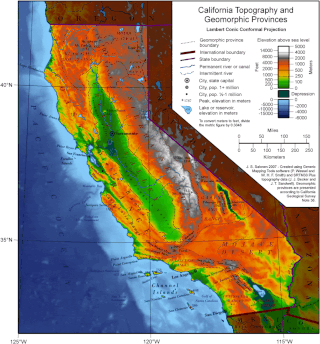
California is a U.S. state on the western coast of North America. Covering an area of 163,696 sq mi (423,970 km2), California is among the most geographically diverse states. The Sierra Nevada, the fertile farmlands of the Central Valley, and the arid Mojave Desert of the south are some of the geographic features of this U.S. state. It is home to some of the world's most exceptional trees: the tallest, most massive, and oldest. It is also home to both the highest and lowest points in the 48 contiguous states.

The Cascade Range or Cascades is a major mountain range of western North America, extending from southern British Columbia through Washington and Oregon to Northern California. It includes both non-volcanic mountains, such as many of those in the North Cascades, and the notable volcanoes known as the High Cascades. The small part of the range in British Columbia is referred to as the Canadian Cascades or, locally, as the Cascade Mountains. The highest peak in the range is Mount Rainier in Washington at 14,411 feet (4,392 m).

The Pacific Coast Ranges are the series of mountain ranges that stretch along the West Coast of North America from Alaska south to Northern and Central Mexico. Although they are commonly thought to be the westernmost mountain range of the continental United States and Canada, the geologically distinct Insular Mountains of Vancouver Island lie farther west.

Arnica is a genus of perennial, herbaceous plants in the sunflower family (Asteraceae). The genus name Arnica may be derived from the Greek arni, "lamb", in reference to the plants' soft, hairy leaves. Arnica is also known by the names mountain tobacco and, confusingly, leopard's bane and wolfsbane—two names that it shares with the entirely unrelated genus Aconitum.
Red Mountain may refer to:
The Pacific Cordillera, also known as the Western Cordillera or simply The Cordillera, is a top-level physiographic region of Canada, referring mainly to the extensive cordillera system in Western and Northwestern Canada that constitutes the northern part of the North American Cordillera. The mountain ranges in this region were covered during the Pleistocene by the Cordilleran Ice Sheet, the extent of which gives perspective on the geographic extent of this region. The cordillera extends from the Alaska's Brooks and Alaska Ranges, southeast through most of the Yukon and British Columbia as well as the southwestern fringe of Northwest Territories and Alberta, to stretch its margin beyond the Canada–United States border with five extensive lobes reaching into the mountain valleys of Montana and Washington.

The North American Cordillera, sometimes also called the Western Cordillera of North America, the Western Cordillera, or the Pacific Cordillera, is the North American portion of the American Cordillera, the mountain chain system along the Pacific coast of the Americas. The North American Cordillera covers an extensive area of mountain ranges, intermontane basins, and plateaus in Western and Northwestern Canada, Western United States, and Mexico, including much of the territory west of the Great Plains.
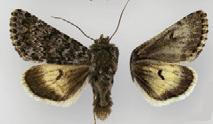
Lasionycta leucocycla is a species of moth of the family Noctuidae. It can be found in Scandinavia, Siberia and northern North America.

Lasionycta secedens is a species of moth in the family Noctuidae. It has a Holarctic distribution. North American populations are distributed from Labrador, northern Manitoba, and Alaska, southward to northern Maine, northern Minnesota, and south-central British Columbia. Subspecies bohemani occurs in northern Eurasia, Alaska and Yukon.

Lasionycta fergusoni is a species of moth in the family Noctuidae. It is found from the southern Washington Cascades through British Columbia and Alberta to southern Yukon.

Lasionycta illima is a moth of the family Noctuidae. It is found from Pink Mountain in north-eastern British Columbia through southern Yukon to eastern Alaska.

Lasionycta perplexa is a moth of the family Noctuidae. It is widely distributed from southern Alaska and Yukon in the north to California, Utah, and Colorado in the South. A disjunct population is found on the east coast of Hudson Bay at Kuujjuaraapik.
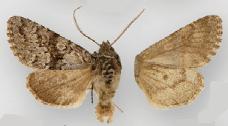
Lasionycta subfuscula is a moth of the family Noctuidae. It is found from south-western British Columbia and south-western Alberta south to southern Oregon in the west and to southern Colorado and Utah in the Rocky Mountains.

Lasionycta quadrilunata is a species of moth in the family Noctuidae. It is found from south-central Alaska down the spine of the Rocky Mountains to Colorado.
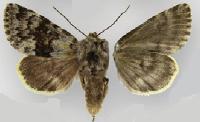
Lasionycta caesia is a moth of the family Noctuidae. It occurs in the Cascade Mountains of northern Washington and the British Columbia Coast Range to 58 degrees north latitude.
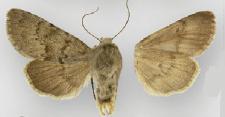
Lasionycta promulsa is a moth of the family Noctuidae. It occurs from Rampart House in northern Yukon to south-western British Columbia in the west and southern New Mexico in the Rocky Mountains.

Lasionycta impingens is a moth of the family Noctuidae. It occurs from southern Yukon to Colorado.

There are 14 species of amphibians and 5 species of reptiles known to occur in Mount Rainier National Park.
This page is based on this
Wikipedia article Text is available under the
CC BY-SA 4.0 license; additional terms may apply.
Images, videos and audio are available under their respective licenses.










